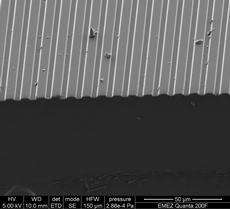New plaster enhances wound healing

(Phys.org) -- Swiss researchers at ETH Zurich have developed a plaster that accelerates wound healing and is easily removed from the wound at any time. Burn victims in particular may profit from this invention in the future.
When one cuts a finger, it is usually sufficient to apply some disinfectant and a simple plaster. The cut will heal in a few days. However, some wounds can take much longer to heal. Burns are a notable example.
Wound healing is dependent on the migration of certain connective tissue cells to the wounded region. These so called fibroblasts normally migrate from the wound edges in a more or less unordered fashion, building new tissue on their way. If migration is impaired, scars result. In bigger wounds, fibroblasts must sometimes travel large distances to enable the creation of new skin – and this takes time.
ETH-Researchers in the group of Dr. Vartan Kurtcuoglu at the Laboratory of Thermodynamics in Emerging Technologies under the leadership of Prof. Dimos Poulikakos have developed a new method to guide fibroblasts quickly and efficiently to where they are needed in the healing process, namely from the edges of a wound to its center. As a result, wound healing is accelerated.
A plaster with a special surface
The interdisciplinary research team consisting of engineers and biologists has developed a specialized silicone plaster. This plaster has many tiny parallel grooves on its surface. In a cell culture experiment, a cell layer was wounded by scratching. When the researchers applied the plaster with its grooves parallel to the wound edges (against the direction of wound healing), the scratch healed as fast as a wound under a plaster without grooves. However, when they placed the grooves perpendicular to the wound edges (in the direction of wound healing), they could observe under the microscope that the wound closed faster. The doctoral student Anastasios Marmaras could thus show that this novel plaster does indeed speed up the healing process.
Fibroblasts follow the direction of the grooves
The researchers could demonstrate that the fibroblasts migrated along the grooves of the new plaster. They therefore hypothesize that these cells, which are much larger than the grooves, chose the path of least resistance by following them. Moving across the grooves would cause more friction than traveling along them.
The grooves do not necessarily have to be arranged in a parallel manner, added Dr. Aldo Ferrari, the lead biologist in the team. Radial arrangement would also be possible, for example to close circular wounds.
Fibroblasts are in direct contact with the plaster, but do not connect to it. Instead, they are guided in purely mechanical fashion by the grooves. Consequently, the plaster can be removed at any time without tearing of cells or tissue. This is completely new, says Vartan Kurtcuoglu. In earlier studies researchers placed cells on materials to which these could adhere. While this did guide the fibroblasts to the wound center, the plaster could not be removed after the healing process was completed.
Practical application is foreseen
So far the ETH-Researchers have tested their new plaster only on single-layer cell cultures. The next goal will be in vivo experiments with which the scientists aim to verify that the method also works on animals or humans.
They see the primary application of the plaster in the treatment of burns. It is hoped that large wounds will also heal significantly faster with this patch and that the organized migration of fibroblasts will reduce scars.
The application and commercialization of the new plaster with the specialized surface appears promising: A patent application for the method has been submitted. According to Dr. Stefan Lux of the ETH-Transfer office, who establishes contacts with companies, interest from industry has already been expressed.
More information: A. Marmaras, et al. Topography-mediated apical guidance in epidermal wound healing. Soft Matter, 2012, DOI: 10.1039/C2SM00030J
Journal information: Soft Matter
Provided by ETH Zurich


















